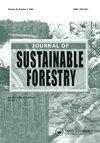尼泊尔中山不同农林业方式的物种组成和碳储量
IF 1.8
4区 农林科学
Q3 FORESTRY
引用次数: 0
摘要
农民正在采用不同的农林业实践,但基于生态系统功能的实践之间的比较研究往往被忽视。我们评估了尼泊尔中部山区采用的两种不同农林业实践(传统和改进)的物种组成和碳储量。结果表明,改良栽培方式中柑橘属(Citrus synensis)的物种丰富度和优势度较高,而传统栽培方式中无花果属(Ficus clavata)的物种均匀度、多样性和优势度较高。相似指数为0.35,表明两种做法之间的物种数量差异为65%。与传统做法相比,改进的做法有更大的树木和更高的频率。碳储量反映了两种做法之间的总碳储量差异不显著,而改进做法的总生物量碳显著高于传统做法。因此,改进传统做法有可能增加生物量,并在同一单位土地内吸收更多的碳。然而,在改进的做法中,保持物种多样性是一个值得关注的问题。我们建议决策者和相关利益相关者在制定促进农林业和减缓气候变化战略的同时,优先考虑改进农林业实践并保持物种多样性。本文章由计算机程序翻译,如有差异,请以英文原文为准。
Species Composition and Carbon Stock in Different Agroforestry Practices in the mid-hills of Nepal
ABSTRACT Farmers are adopting different agroforestry practices, but comparative studies between the practices based on ecosystem functions are often ignored. We assessed species composition and carbon stock in two different agroforestry practices (traditional and improved) adopted in the mid-hills of Nepal. We found higher species richness and dominancy of Citrus synenssis (fruit species) in the improved practice, whereas we found higher species evenness, diversity, and dominance of Ficus clavata (fodder species) in the traditional practice. 0.35 of the similarity index between the two practices indicated that there was 65% difference in species number between the two practices. The improved practice had larger trees with higher frequency compared to traditional practice. The carbon inventory reflected that the total carbon stock between the two practices was insignificant, whereas the total biomass carbon was significantly higher in the improved practice than in the traditional practice. Therefore, improvement in traditional practices has the potential to increase biomass and sequester more carbon within the same unit of land. However, maintaining species diversity is a concern in the improved practice. We suggest policymakers and concerned stakeholders for prioritizing improved agroforestry practice and maintain species diversity while designing strategies for agroforestry promotion and climate change mitigation.
求助全文
通过发布文献求助,成功后即可免费获取论文全文。
去求助
来源期刊

Journal of Sustainable Forestry
Social Sciences-Geography, Planning and Development
CiteScore
3.90
自引率
12.50%
发文量
42
期刊介绍:
Journal of Sustainable Forestry publishes peer-reviewed, original research on forest science. While the emphasis is on sustainable use of forest products and services, the journal covers a wide range of topics from the underlying biology and ecology of forests to the social, economic and policy aspects of forestry. Short communications and review papers that provide a clear theoretical, conceptual or methodological contribution to the existing literature are also included in the journal.
Common topics covered in the Journal of Sustainable Forestry include:
• Ecology, management, recreation, restoration and silvicultural systems of all forest types, including urban forests
• All aspects of forest biology, including ecophysiology, entomology, pathology, genetics, tree breeding, and biotechnology
• Wood properties, forest biomass, bioenergy, and carbon sequestration
• Simulation modeling, inventory, quantitative methods, and remote sensing
• Environmental pollution, fire and climate change impacts, and adaptation and mitigation in forests
• Forest engineering, economics, human dimensions, natural resource policy, and planning
Journal of Sustainable Forestry provides an international forum for dialogue between research scientists, forest managers, economists and policy and decision makers who share the common vision of the sustainable use of natural resources.
 求助内容:
求助内容: 应助结果提醒方式:
应助结果提醒方式:


